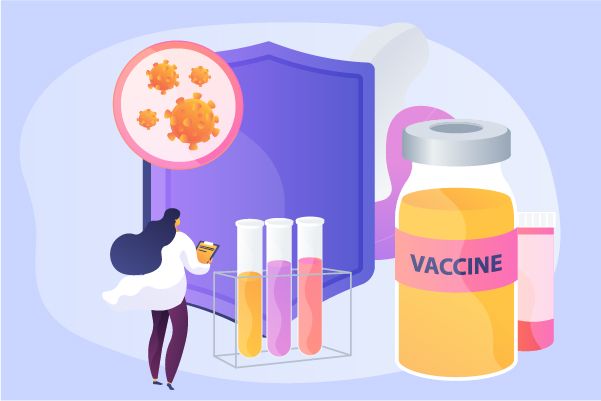April 2025 Therapeutic Breakthroughs: From FcRn-Targeted mAbs to COL7 Gene Therapy in DEB
In April 2025, a series of innovative drugs targeting various disease areas received regulatory approval, ranging from rare diseases such as dystrophic epidermolysis bullosa (DEB) to more prevalent conditions like chronic urticaria, polyarticular juvenile idiopathic arthritis (pJIA), and hospital-acquired pneumonia (HAP). These therapies not only represent the forefront of scientific advancement but also reflect modern medicine’s ongoing pursuit of precision and personalized treatment.
1. Nipocalimab-aahu
Nipocalimab-aahu (brand name: IMAAVY), developed by Janssen Biotech, a subsidiary of Johnson & Johnson, is a humanized monoclonal antibody targeting the neonatal Fc receptor (FcRn) for the treatment of generalized myasthenia gravis (gMG). It received its first approval in the United States on April 29, 2025, for this indication.
Nipocalimab is an IgG1 monoclonal antibody that selectively binds to and inhibits the interaction between FcRn and IgG, thereby accelerating the degradation of pathogenic IgG antibodies and reducing their concentration in the bloodstream. Under physiological conditions, FcRn binds to the Fc region of IgG, protecting it from lysosomal degradation and prolonging its half-life. However, in autoimmune diseases, this mechanism contributes to the persistence and accumulation of pathogenic IgG. By competitively binding to FcRn, nipocalimab prevents this interaction, leading to the lysosomal degradation of IgG. This targeted mechanism is especially well-suited for diseases driven by IgG-mediated pathogenesis, such as generalized myasthenia gravis and warm autoimmune hemolytic anemia. Compared to traditional immunosuppressants or intravenous immunoglobulin (IVIG), nipocalimab offers effective reduction of pathogenic antibody load without broad immunosuppression, thus providing better safety and tolerability.
In pivotal clinical trials for gMG, nipocalimab demonstrated significant clinical improvement, particularly in muscle function scores and reduction in exacerbation frequency, outperforming placebo. The treatment showed a rapid onset and durable efficacy. Additionally, its subcutaneous route of administration enhances patient adherence. Even after its approval, Johnson & Johnson plans to continue long-term follow-up studies to assess real-world safety and effectiveness, as well as explore broader applications in other rare autoimmune conditions.
Currently, there are several therapeutic options available for gMG and other IgG-mediated autoimmune diseases, including corticosteroids, immunosuppressants, IVIG, plasma exchange, and newer targeted biologics. For instance, Argenx’s efgartigimod, a recombinant FcRn-targeting fusion protein, has been approved in multiple countries for gMG. While it shares a similar mechanism with nipocalimab, it is not antibody-based. Nipocalimab, as a monoclonal antibody, may offer stronger binding affinity and longer half-life, potentially making it more suitable for long-term maintenance therapy. Other competitors include Soliris (eculizumab) from Alexion and Rituxan (rituximab), which work via complement inhibition and B cell depletion, respectively, but are costly and require frequent infusions.
2. Prademagene zamikeracel
Prademagene zamikeracel (EB-101), developed by Abeona Therapeutics, is a gene therapy approved on April 29, 2025, in the United States for the treatment of dystrophic epidermolysis bullosa (DEB).
Prademagene zamikeracel is designed to restore the expression of type VII collagen (COL7) by delivering a functional COL7A1 gene to the patient’s own keratinocytes. DEB is a genetic disorder caused by mutations in the COL7A1 gene, leading to insufficient COL7 production and resulting in extremely fragile skin prone to blistering and wounds. This gene therapy uses a retroviral vector to transfer the functional COL7A1 gene into autologous keratinocytes, enabling these cells to synthesize and secrete normal COL7, which is essential for anchoring fibrils that maintain dermal-epidermal cohesion. The therapy employs a modified retroviral vector that efficiently integrates the gene into the host genome, ensuring long-term and stable gene expression. Its specificity and safety are further enhanced by targeting only the affected skin cells, minimizing off-target effects on other tissues or organs.
Clinical studies have shown that Prademagene zamikeracel significantly improves wound healing and reduces blister formation, thereby enhancing patients' quality of life, without evidence of serious adverse effects or drug interactions. Abeona Therapeutics has employed advanced gene-editing technologies and manufacturing processes to ensure drug stability and bioavailability. Pharmacokinetic studies suggest that its efficacy is comparable or even superior to other gene therapies in development. Post-approval, the company continues to monitor the therapy closely, collecting additional clinical data to optimize its formulation and usage guidelines. A Phase IV clinical trial is planned to explore new indications and long-term outcomes. Preliminary findings suggest potential applicability in other types of inherited skin disorders.
Currently, most treatments for DEB focus on supportive care, such as wound management, infection control, and pain relief, which do not address the underlying genetic cause. In contrast, Prademagene zamikeracel offers a curative approach by directly correcting the disease-causing gene mutation. Competing therapies include beremagene geperpavec (B-VEC) by Krystal Biotech, a gene therapy based on a herpes simplex virus (HSV) vector platform. Although both therapies aim at gene correction, they differ in their vector systems and gene delivery mechanisms.
3. Penpulimab*
Penpulimab, developed by Akeso Biopharma Co., Ltd. (Zhongshan, China), was approved by the U.S. FDA on April 23, 2025, under the brand name AK105. It is indicated for the treatment of recurrent or metastatic nasopharyngeal carcinoma (NPC) in adult patients who have failed prior first-line therapy. As a fully humanized IgG1 PD-1 monoclonal antibody, Penpulimab features unique structural optimizations and potentially improved safety characteristics.
Penpulimab is a fully human IgG1 subtype monoclonal antibody targeting programmed cell death protein 1 (PD-1). Its mechanism of action centers on modulating T-cell–mediated anti-tumor immune responses. PD-1 is an immune checkpoint molecule expressed on activated T cells; when bound to its ligands (PD-L1/PD-L2), it inhibits T-cell activity, allowing tumors to evade immune surveillance. Penpulimab binds with high affinity to PD-1, blocking its interaction with PD-L1/PD-L2 and restoring the immune system’s ability to recognize and destroy tumor cells. Unlike many other PD-1 antibodies that use the IgG4 subtype, Penpulimab adopts an IgG1 framework, which enables a stronger antibody-dependent cellular cytotoxicity (ADCC) effect, potentially enhancing immune clearance within the tumor microenvironment. Additionally, the Fc region of Penpulimab has been engineered to reduce undesired immune activation, aiming to improve efficacy while minimizing immune-related adverse events.
Penpulimab’s development has focused on nasopharyngeal carcinoma, a malignancy with high prevalence in China and other parts of Asia. In pivotal Phase II clinical trials, Penpulimab demonstrated a notable objective response rate (ORR) and durable disease control in PD-L1–positive patients, with especially pronounced efficacy in Epstein-Barr virus–associated NPC. Data showed that more than 30% of patients achieved tumor reduction, with many experiencing long-lasting responses, and some even achieving complete remission. The FDA approval was granted under Priority Review, recognizing Penpulimab’s clear clinical value in treating this difficult-to-manage cancer. Akeso employed a precision medicine approach in its clinical development by focusing on PD-L1–positive and previously treated advanced NPC patients, thereby improving response rates and optimizing the risk-benefit profile—reflecting the current trend toward individualized cancer immunotherapy.
Currently, several blockbuster PD-1/PD-L1 inhibitors—such as Keytruda (pembrolizumab, Merck), Opdivo (nivolumab, Bristol Myers Squibb), and Tecentriq (atezolizumab, Roche)—have been approved for various solid tumors, including melanoma, non-small cell lung cancer, and head and neck squamous cell carcinoma. Some studies have explored their use in NPC. However, Penpulimab is the first PD-1 inhibitor formally approved by the FDA specifically for nasopharyngeal carcinoma, filling a critical gap in treatment. While other PD-1 inhibitors may be used off-label in clinical practice for NPC, they have not yet received regulatory approval for this specific indication.
4. Linvoseltamab
Linvoseltamab (brand name: Lynozyfic), developed by Regeneron Pharmaceuticals, is a bispecific T-cell engager approved on April 23, 2025, in the European Union, Iceland, Liechtenstein, and Norway for the treatment of relapsed or refractory multiple myeloma (RRMM).
Linvoseltamab is a bispecific antibody targeting both B-cell maturation antigen (BCMA) on myeloma cells and CD3 on T cells. It works by simultaneously binding to BCMA-expressing tumor cells and CD3-positive T cells, effectively forming a bridge between them. This interaction leads to the formation of an immunological synapse, activating T cells to release cytotoxic molecules such as perforin and granzymes, which induce direct tumor cell lysis. Beyond cell killing, this bispecific engagement enhances T-cell activation, proliferation, and persistence—amplifying the overall anti-tumor immune response.
Unlike conventional monoclonal antibodies, Linvoseltamab does not rely on endogenous antigen presentation to activate T cells. Its ability to directly stimulate T cells gives it a significant therapeutic advantage in targeting BCMA-positive myeloma cells. Preclinical and clinical data have shown that Linvoseltamab not only suppresses tumor growth but also reduces the risk of relapse, offering a novel and promising treatment strategy for patients with advanced myeloma.
Clinical studies have demonstrated Linvoseltamab’s efficacy in alleviating symptoms, prolonging progression-free survival (PFS) and overall survival (OS), and significantly improving quality of life, with no major adverse events or drug interactions reported. Regeneron has applied advanced bispecific antibody design and manufacturing technologies to ensure drug stability, bioavailability, and consistent pharmacokinetic profiles. Post-marketing, the company is continuing real-world monitoring, collecting further clinical data to optimize formulation and usage, and plans to initiate Phase IV trials to investigate additional indications and long-term benefits. Preliminary research suggests potential activity against other BCMA-positive hematologic malignancies as well.
In the current treatment landscape for RRMM, a variety of therapeutic modalities are available, including monoclonal antibodies, CAR-T cell therapies, and targeted small molecules. For example, Darzalex (daratumumab, Johnson & Johnson) and Blenrep (belantamab mafodotin, GSK) are widely used monoclonal antibodies that target CD38 and BCMA, respectively. While effective, these agents often require combination regimens to maximize their benefit. In contrast, Linvoseltamab as a bispecific T-cell engager offers a standalone, efficient, and simplified treatment approach by directly activating T cells without the need for additional immunomodulatory agents.
Other competitors include Abecma (idecabtagene vicleucel) from bluebird bio, a CAR-T therapy targeting BCMA, which has been approved for relapsed or refractory multiple myeloma. Despite their efficacy, CAR-T therapies are complex and costly, making Linvoseltamab a potentially more accessible and scalable option in this therapeutic area.
5. Ebdarokimab
Ebdarokimab (AK-101), developed by Akeso Biopharma Co., Ltd., is a monoclonal antibody approved in China on April 15, 2025, for the treatment of plaque psoriasis.
Ebdarokimab is a monoclonal antibody specifically targeting the IL-17A/F heterodimer, functioning by binding to and inhibiting this heterodimer to suppress inflammatory responses and prevent tissue damage. IL-17A and IL-17F are pro-inflammatory cytokines that can act individually or as a heterodimer, activating multiple cell types such as keratinocytes, fibroblasts, and endothelial cells. This activation triggers a cascade of inflammatory responses contributing to the pathogenesis of psoriasis and other autoimmune diseases. By binding to the IL-17A/F heterodimer and blocking its interaction with receptors, Ebdarokimab disrupts downstream signaling pathways, reduces the release of inflammatory mediators, and inhibits cell proliferation—thereby alleviating inflammation at affected sites. This targeted mechanism against the heterodimer offers more comprehensive symptom control and potentially fewer side effects.
Moreover, studies suggest that the IL-17A/F heterodimer plays a critical role in ulcerative colitis, providing a theoretical foundation for the potential use of Ebdarokimab in other immune-related diseases.
Clinical data show that Ebdarokimab significantly improves skin lesion scores (e.g., PASI scores), and reduces symptoms such as erythema and scaling, markedly enhancing patient quality of life, with no serious adverse reactions or drug interactions observed. Akeso has employed advanced monoclonal antibody production technologies and process optimization to ensure product stability and bioavailability, and pharmacokinetic studies have demonstrated comparable or superior efficacy to similar agents. Even after approval, the company continues post-marketing surveillance and plans Phase IV clinical trials to explore additional indications and long-term outcomes. Some research suggests Ebdarokimab may also have therapeutic potential in ulcerative colitis.
Currently, the therapeutic landscape for plaque psoriasis includes several important drug classes such as TNF-α inhibitors, IL-17A inhibitors, and other biologics. Cosentyx (secukinumab, Novartis) and Taltz (ixekizumab, Eli Lilly) are widely used IL-17A inhibitors that specifically bind to and neutralize IL-17A to relieve psoriasis symptoms. Although effective, they only target the IL-17A monomer and do not block the IL-17A/F heterodimer. In contrast, Ebdarokimab offers a more comprehensive therapeutic approach by targeting the heterodimer, potentially delivering stronger inflammation control and reducing relapse rates. Other competitors include Stelara (ustekinumab, Johnson & Johnson), an IL-12/23 inhibitor approved for moderate-to-severe plaque psoriasis.
6. Desvenlafaxine Benzoate
Desvenlafaxine Benzoate (brand name Desvela, 데스베라서방정), developed by Nexpharm Korea, is a small-molecule antidepressant approved in South Korea on April 9, 2025, for the treatment of major depressive disorder (MDD).
Desvenlafaxine Benzoate is a selective serotonin and norepinephrine reuptake inhibitor (SNRI). It works by inhibiting the reuptake of serotonin (5-HT) and norepinephrine (NE) into presynaptic neurons, thereby increasing the concentrations of these neurotransmitters in the synaptic cleft, which helps regulate mood and relieve depressive symptoms. By binding to serotonin and norepinephrine transporters, Desvenlafaxine Benzoate prevents their reabsorption into neurons, allowing greater neurotransmitter availability to exert mood-enhancing effects. This dual mechanism of action helps restore neurotransmitter balance in the brain, improving emotional state and reducing symptoms of depression. It also has mild dopamine reuptake inhibition, which may further contribute to its antidepressant efficacy.
Compared to other antidepressants, Desvenlafaxine Benzoate demonstrates a favorable dose-response and safety profile, enabling more effective symptom management with fewer side effects.
Clinical studies have shown that Desvenlafaxine Benzoate significantly improves depressive symptoms and enhances patient quality of life, while reducing the frequency and severity of depressive episodes. Nexpharm Korea has applied advanced drug design and development technologies to ensure drug stability and bioavailability, and pharmacokinetic studies have confirmed comparable or superior efficacy to similar agents. Post-approval, the company continues to monitor the product, collect clinical data, and refine the formulation and usage guidelines. Plans are in place for Phase IV clinical trials to evaluate additional indications and long-term effectiveness.
In the MDD treatment landscape, several major drug classes are used, including selective serotonin reuptake inhibitors (SSRIs), tricyclic antidepressants (TCAs), and other SNRIs. Notable examples include Pristiq (desvenlafaxine, Pfizer) and Effexor XR (venlafaxine extended-release, Wyeth)—both widely used SNRIs that act through similar mechanisms. Pristiq is known for its good tolerability and relatively low incidence of side effects, while Effexor XR is valued for its broad spectrum of indications. In comparison, Desvenlafaxine Benzoate developed by Nexpharm Korea incorporates a benzoate salt structure, offering enhanced stability and bioavailability, improved efficacy, and reduced side effects. Other competitors include Cymbalta (duloxetine, Eli Lilly), a widely used SNRI for depression and chronic pain management.
7. BARYTHRAX
BARYTHRAX (GC-1109), a recombinant anthrax vaccine developed by GC Biopharma, was first approved in South Korea on April 8, 2025, for the prevention of anthrax infection.
This recombinant vector-based anthrax vaccine is developed through genetic engineering and is designed to express and deliver the protective antigen (PA) of Bacillus anthracis, stimulating a specific immune response. The vaccine employs recombinant technology to insert the gene encoding the anthrax protective antigen into a viral or bacterial vector. Upon administration, these vectors express and release the PA antigen in the human body, which is then recognized by the host immune system—triggering both humoral and cellular immune responses, generating specific antibodies and memory T cells against Bacillus anthracis. Once the individual is exposed to the pathogen, the primed immune system can rapidly activate, neutralize toxins, and eliminate the bacteria, thus preventing disease onset and progression.
Compared to traditional inactivated or live-attenuated vaccines, this recombinant vaccine offers enhanced safety, as it contains no live pathogens and only expresses selected antigenic components, thereby minimizing the risk of adverse reactions.
Clinical studies have shown that the vaccine induces high-titer antibody responses, significantly enhancing immunity in subjects without serious adverse events. GC Biopharma applied advanced vector design and manufacturing technologies to ensure the vaccine’s stability and immunogenicity and conducted detailed pharmacokinetic and immunological studies demonstrating that the product provides equal or superior performance compared to existing vaccines. The company continues post-marketing surveillance and plans Phase IV trials to further optimize the formulation, usage guidelines, and explore additional indications and long-term efficacy.
Currently, several key vaccine types are available for anthrax prevention, including inactivated, live-attenuated, and recombinant protein vaccines. BioThrax (manufactured by Emergent BioSolutions) is one of the most widely used anthrax vaccines, made from a cell-free extract of Bacillus anthracis PA. Although approved in multiple countries and widely used, BioThrax requires multiple doses and may cause local injection site reactions and mild side effects. In contrast, BARYTHRAX, as a novel recombinant vector vaccine, offers a safer and more effective alternative, potentially requiring fewer doses to establish durable immunity. Competing products include NuThrax (also from Emergent BioSolutions), a next-generation vaccine combining BioThrax with the CpG 7909 adjuvant to enhance the speed and strength of immune responses.
8. Dalnacogene Ponparvovec
Dalnacogene ponparvovec (also known as BBM-H901), developed by Belief BioMed, is an adeno-associated virus (AAV)-based gene therapy approved in China on April 8, 2025, for the treatment of Hemophilia B.
Dalnacogene ponparvovec delivers a functional human coagulation factor IX (FIX) gene into liver cells to correct the coagulation deficiency caused by mutations in the FIX gene. Using an AAV vector carrying an optimized FIX gene sequence, the therapy targets hepatocytes after administration, enabling the integration and expression of the FIX gene within the patient’s cells. This leads to sustained production and secretion of functional FIX protein, restoring coagulation ability.
The therapy incorporates advanced gene engineering and sequence optimization to produce FIX protein with enhanced activity and stability, significantly improving therapeutic outcomes. Unlike traditional FIX replacement therapies, which require regular infusions, Dalnacogene ponparvovec offers a one-time treatment with long-lasting effects, reducing treatment burden and improving quality of life.
Clinical studies have demonstrated that Dalnacogene ponparvovec significantly increases FIX protein levels and reduces bleeding episodes, leading to marked improvements in patients' coagulation function and overall well-being. Belief BioMed has employed cutting-edge AAV vector design and manufacturing technology to ensure product stability and bioavailability, and pharmacokinetic studies confirm comparable or superior efficacy to other gene therapies. Post-approval, the company is maintaining ongoing safety monitoring, gathering additional real-world data, and planning Phase IV clinical trials to explore broader indications and long-term benefits. Preliminary studies suggest the therapy may have potential in treating other inherited disorders.
In the treatment landscape for Hemophilia B, current options include recombinant FIX protein replacement therapies, non-replacement therapies, and other gene therapies. Alprolix (a recombinant FIX-Fc fusion protein by Bioverativ) and BeneFIX (recombinant FIX by Pfizer) are widely used replacements that supplement exogenous FIX to correct coagulation deficits but require frequent infusions, which can be inconvenient. By contrast, Dalnacogene ponparvovec, as a single-administration AAV-based gene therapy, offers a long-term solution with sustained FIX expression and reduced treatment frequency.
Other competitors include Valoctocogene roxaparvovec (BioMarin), an AAV gene therapy for Hemophilia A. Although targeting a different clotting factor, its clinical development has provided valuable insights applicable to the advancement of Dalnacogene ponparvovec.
9. Sitagliptin Phosphate Hydrate / Empagliflozin L-Proline
Sitagliptin Phosphate Hydrate / Empagliflozin L-Proline (brand name: Empamax, 엠파맥스에스정), developed by Chong Kun Dang Pharmaceutical Corp., is a small-molecule combination drug for the treatment of type 2 diabetes mellitus (T2DM). It was first approved in South Korea on April 7, 2025.
Sitagliptin phosphate is a dipeptidyl peptidase-4 (DPP-4) inhibitor that works by blocking the enzymatic degradation of glucagon-like peptide-1 (GLP-1) and glucose-dependent insulinotropic polypeptide (GIP), thereby prolonging the action of these incretin hormones. GLP-1 and GIP enhance insulin secretion and suppress glucagon release, leading to improved glycemic control. Sitagliptin also helps preserve β-cell function and slows the progression of T2DM.
Empagliflozin, on the other hand, is a sodium-glucose co-transporter 2 (SGLT2) inhibitor that lowers blood glucose levels by inhibiting glucose reabsorption in the kidneys and increasing urinary glucose excretion. The combination of a DPP-4 inhibitor and an SGLT2 inhibitor offers a dual mechanism of action that not only improves glycemic control but also provides additional cardiovascular and weight management benefits. Empagliflozin promotes weight loss through glucosuria, while sitagliptin preserves β-cell function—making this fixed-dose combination particularly effective for comprehensive T2DM management.
Clinical results demonstrate that Sitagliptin Phosphate Hydrate / Empagliflozin L-Proline significantly reduces HbA1c, improves glycemic control, and lowers the incidence of hypoglycemia, while also supporting weight loss. Chong Kun Dang utilized advanced formulation and drug development technologies to ensure the drug’s stability and bioavailability, supported by detailed pharmacokinetic studies showing equal or superior efficacy compared to individual agents. The company continues post-marketing surveillance and plans Phase IV clinical trials to further optimize dosing, explore long-term outcomes, and evaluate additional indications—such as cardiovascular protection, which has been suggested by emerging data.
Currently, the T2DM treatment landscape includes various key drug classes such as DPP-4 inhibitors, SGLT2 inhibitors, and other oral hypoglycemic agents. Januvia (Merck) and Jardiance (Boehringer Ingelheim) are two widely used monotherapies that lower blood glucose via different mechanisms. Januvia is known for its tolerability and low risk of hypoglycemia, while Jardiance is favored for its cardiovascular benefits. Compared with these monotherapies, Chong Kun Dang’s fixed-dose combination offers a more comprehensive therapeutic option, especially for patients requiring simultaneous glycemic control and weight management. Competing products include Farxiga (AstraZeneca, an SGLT2 inhibitor) and Trulicity (Eli Lilly, a GLP-1 receptor agonist), both of which use different mechanisms to support glycemic control.
10. Atrasentan
Atrasentan, marketed under the brand name Vanrafia, is an innovative small-molecule drug developed by Novartis Pharmaceuticals for the treatment of various kidney diseases. It received its first approval in the United States on April 2, 2025, for the treatment of IgA nephropathy (IgAN). As a selective endothelin receptor antagonist, Atrasentan offers patients a more effective and targeted therapeutic option, with the potential for global adoption to further improve treatment outcomes and quality of life.
Atrasentan is a selective endothelin A (ETA) receptor antagonist that functions primarily by blocking the binding of endothelin-1 (ET-1) to the ETA receptor, thereby reducing vasoconstriction and inflammatory responses. ET-1 is a potent vasoconstrictor involved in regulating blood pressure and fluid-electrolyte balance. Under pathological conditions such as kidney disease, ET-1 contributes to excessive vasoconstriction and tissue damage. By selectively antagonizing ETA receptors, Atrasentan significantly lowers intraglomerular hypertension, reduces proteinuria, and helps preserve renal function. Additionally, Atrasentan suppresses the release of inflammatory mediators and mitigates renal fibrosis, thereby slowing disease progression. This dual mechanism of action allows Atrasentan to effectively slow the decline in kidney function and improve long-term outcomes in patients with IgA nephropathy and other glomerular diseases.
Clinical studies have demonstrated that Atrasentan excels in reducing proteinuria and preserving renal function, significantly lowering the risk of kidney function deterioration. Novartis applied advanced drug design and development technologies to ensure drug stability and bioavailability, and conducted detailed pharmacokinetic studies, confirming that Atrasentan offers comparable or superior efficacy relative to similar therapies. Even after market launch, the company continues post-marketing surveillance to collect real-world clinical data, with plans to initiate Phase IV clinical trials to explore additional indications and long-term benefits. Notably, current research suggests that Atrasentan may also be effective in treating other glomerular diseases, such as focal segmental glomerulosclerosis (FSGS) and Alport syndrome.
Currently, several important drug classes are available for the treatment of IgA nephropathy and other kidney diseases, including but not limited to angiotensin-converting enzyme (ACE) inhibitors, angiotensin II receptor blockers (ARBs), glucocorticoids, and immunosuppressants. For example, ACE inhibitors and ARBs are widely used to control hypertension and reduce proteinuria, but their mechanisms primarily focus on modulating the renin-angiotensin system, without directly targeting ET-1-mediated pathways. In contrast, Atrasentan, as a selective ETA receptor antagonist, provides a novel therapeutic approach by more effectively addressing glomerular hypertension and inflammatory responses. Other competing therapies include immunosuppressants such as cyclophosphamide and mycophenolate mofetil, which are commonly used to treat severe glomerular diseases but are often associated with significant adverse effects.
Conclusion
The wave of new drug approvals in April 2025 not only reflects the current advancements in pharmaceutical science and technology but also serves as a critical indicator of the future direction of medical innovation. Increasingly, targeted therapies and biologics are being developed to treat complex and difficult-to-cure diseases. This trend marks the gradual mainstream adoption of personalized medicine, which aims to deliver more effective and less toxic treatments by precisely targeting the key mechanisms of disease pathogenesis.
How to obtain the latest research advancements in the field of biopharmaceuticals?
In the Synapse database, you can keep abreast of the latest research and development advances in drugs, targets, indications, organizations, etc., anywhere and anytime, on a daily or weekly basis. Click on the image below to embark on a brand new journey of drug discovery!




